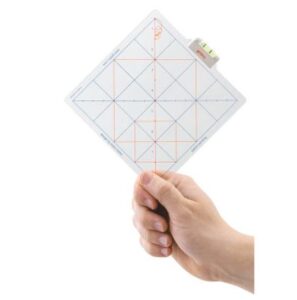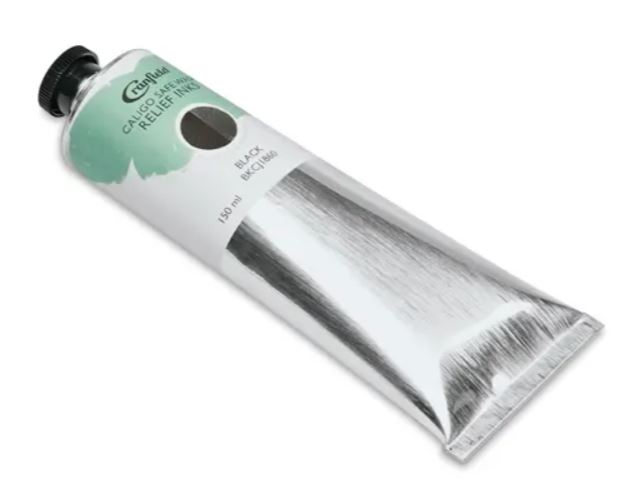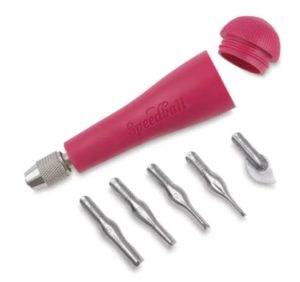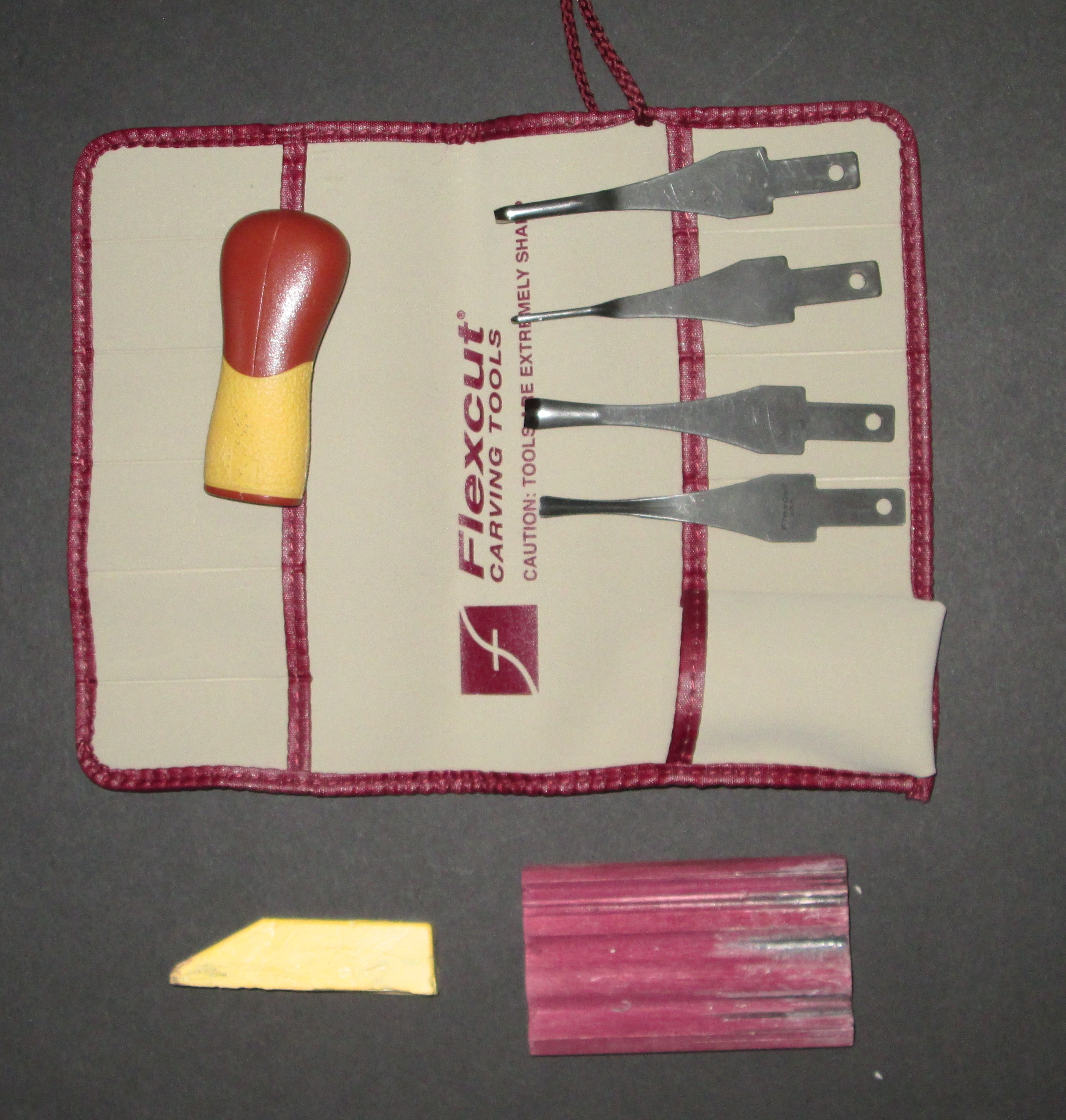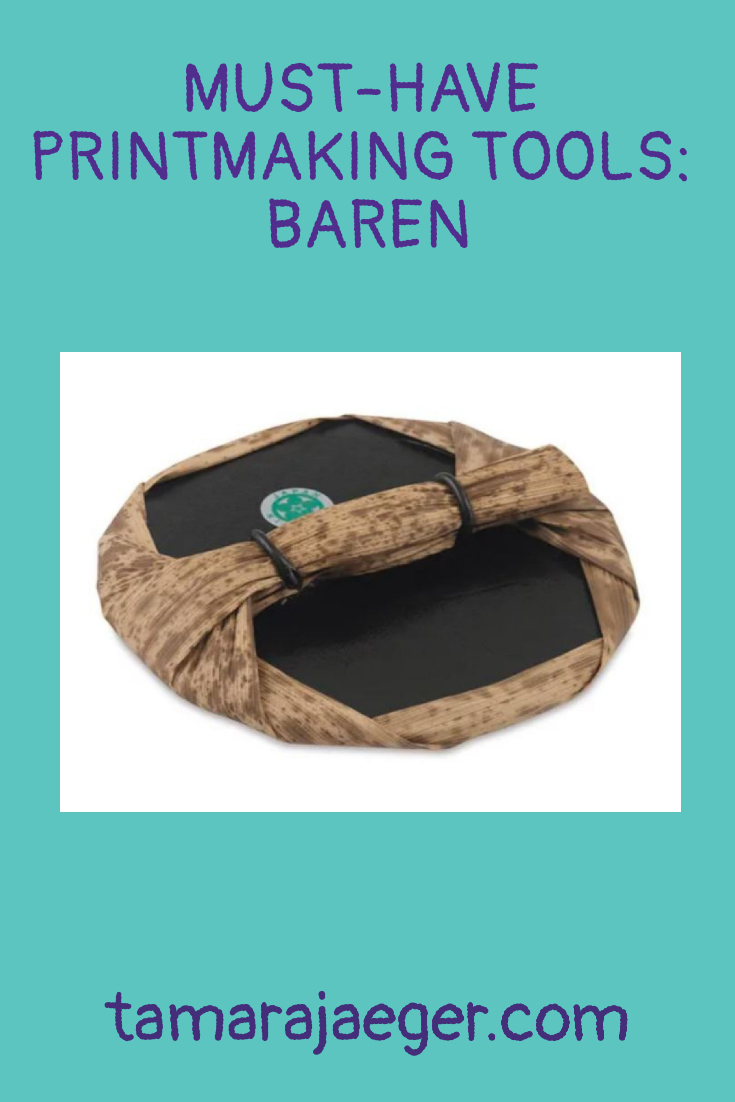Posts in Category: Art Materials
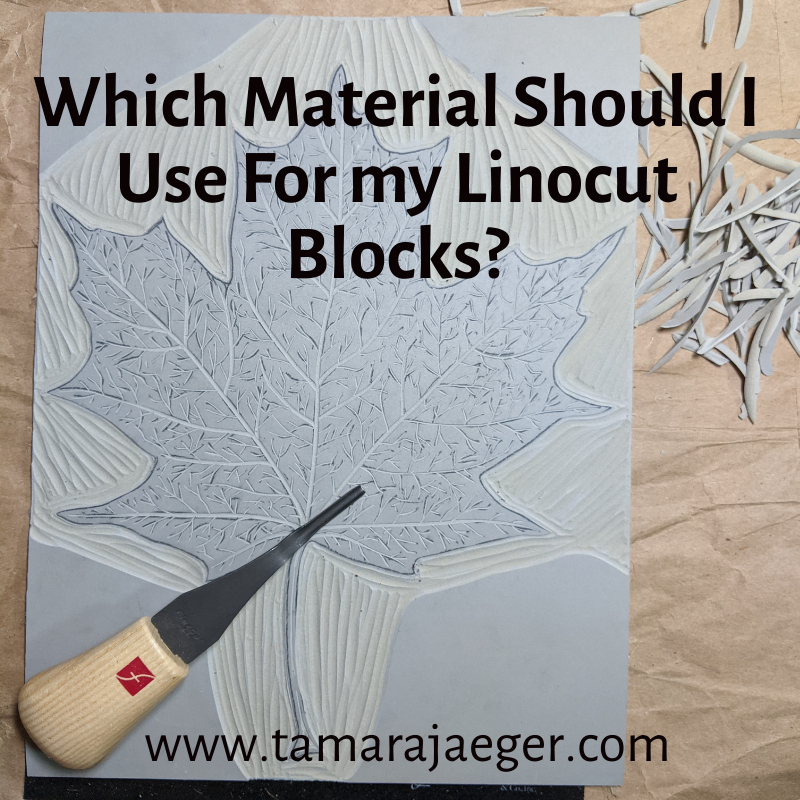

Which Material Should I Use For my Linocut Blocks?
Linocut is a printmaking technique similar to woodcut that uses a carved linoleum block to create an image. The block is inked and then pressed onto paper to create the print. You can use a variety of different materials for linocut blocks but like any material, each has advantages and disadvantages.

Linocut printing block materials: Speedy Carve, battleship grey lino, golden lino, Speedy-Cut
Traditional Linoleum: Traditional lino is made from a burlap-backed grey linoleum. This is the most common type of linocut block material and the one you’re most likely familiar with if you’ve done any linocut printmaking in school. It’s relatively inexpensive and easy to carve and produces sharp, detailed prints. However, traditional linoleum can become brittle with age and can crack if it is not handled carefully.
There’s also a version of traditional linoleum that is tan or golden in color rather than grey. This material is generally a bit softer and easier to carve than the grey version and doesn’t become as brittle over time but still produces sharp details.
You can get traditional linoleum that is mounted on wooden blocks or unmounted. Mounted lino is sturdier and less likely to curl or warp, because it is supported by the wooden block, but thicker, which can make positioning the paper a little more difficult.
I typically use unmounted lino because when I print, I place the block on the table first, then lay the paper down over it and apply pressure with a baren on the paper. You can place also the paper on the table, then place the inked block face-down on the paper and apply pressure to the back of the block. This method typically works better for the thicker mounted blocks and printing using a press rather than hand printing.
Vinyl Linoleum: Vinyl lino is a newer type of linocut block material that is made from a synthetic material. It is more expensive than traditional lino but is more durable and less likely to crack. The most common vinyl lino is Japanese vinyl, which has a blue side and a green side along with a black center. Either or both sides of the block can be carved. It’s a little softer than traditional lino but still produces sharp, detailed prints though it can be a little difficult to transfer the design to the block.
Softcut Lino: Softcut lino is made from a softer, more flexible rubber-like material. It’s easier to carve than traditional lino, especially for intricate designs, and is also less likely to crack. However, Softcut lino is more expensive than traditional lino and it can be difficult to produce really sharp prints.
Rubber: Rubber is another popular material for linocut blocks. It is more flexible, less likely to crack, and easier to carve than linoleum, making it a good choice for beginners. Its flexibility also means it can be used to print on curved surfaces. However, rubber can be more expensive than linoleum and can distort under pressure, making the prints less clear. Speed Ball Speedy-Carve is a common brand.
Foam: Foam is another material that is becoming increasingly popular for linocut blocks. It is inexpensive, very easy to carve, and produces soft lines. However, foam is not as durable as linoleum or rubber and can easily be damaged.
The best material for you will depend on your individual needs and preferences. If you are looking for a traditional material that is easy to carve and produces sharp lines, then traditional linoleum—either the battleship grey or the golden version—is a good choice. If you are looking for a material that is more flexible and less likely to crack, then rubber or vinyl are good options. If you are looking for a material that is easy to carve and inexpensive, then foam may be a good choice.

Carved linocut blocks
Want to stay up to date and see more of what I’m working on? Sign up for my mailing list here and get a FREE digital download of an exclusive tiger linocut print. (I promise not to be spammy with my emails—I hate that too!)
* Please note that this post contains affiliate links and any sales made through such links will reward me a small commission – at no extra cost for you.
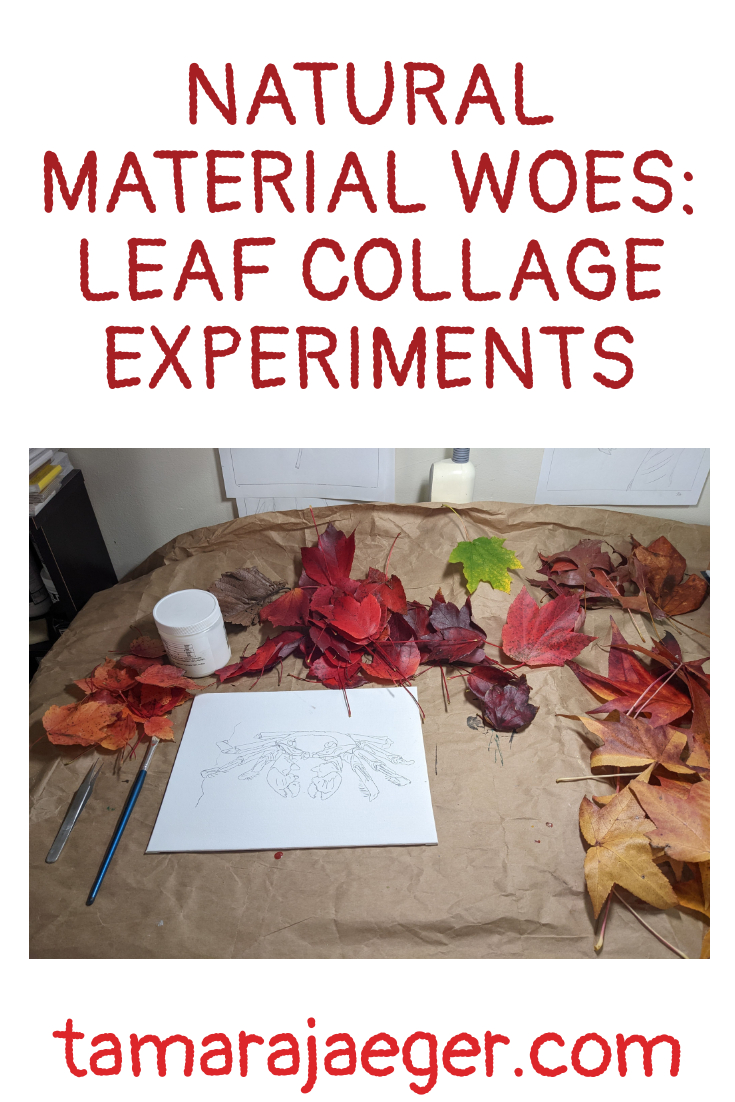

Natural Material Woes: Leaf Collage Experiments
I wrote previously about an experiment I did using leaves to make a collage. If you missed it, you can find the post here.
A year later, I know you’re all wondering, “How is the Red Panda leaf collage looking now?”
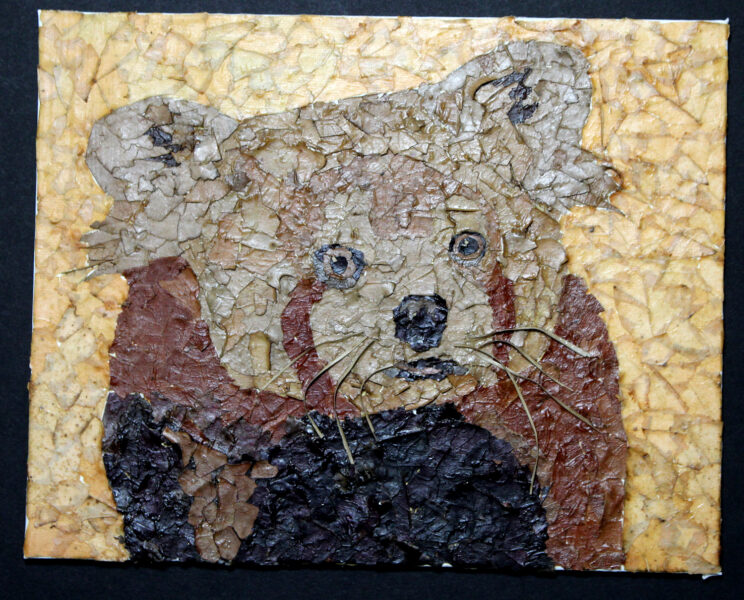
Well, actually not too bad. Most of the piece still looks pretty much the same as it did when it was first made. The only noticeable change is that the color of the yellow leaves in the background has faded. While that’s not ideal from an aging/longevity standpoint, aesthetically I’m not exactly crushed. I didn’t really like the super bright yellow color it had originally, so this more muted yellow is a bit nicer to look at.
I suspect it’s at least partially due to the yellow leaves being a bit ‘fresher’ than the brown ones, so the color wasn’t as stable. This, of course, begs the question: How will red, orange, or green leaves hold up over time?
This is definitely something that needs looking into! So, I created another experimental test piece, using red and green leaves, to see how those colors will age.
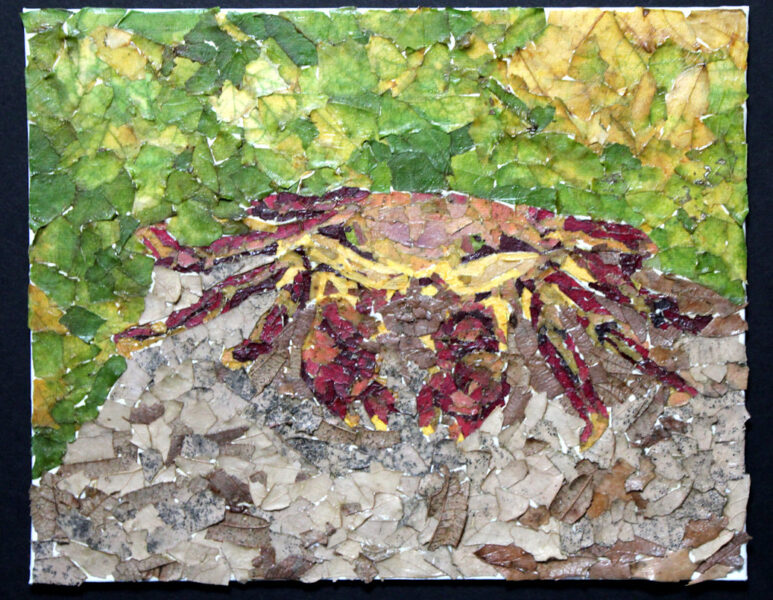
Here we have a red crab from the Galapagos islands. I thought he was pretty cool-looking and he had the right colors, so he was my test victim. I suspect I should have used a subject that had larger areas of red, like a cardinal, but oh, well! I’ll keep you posted on how this one ages as well.
If you’re curious about the materials I used (other than leaves!), here’s a list:
*Golden Acrylic Soft Gel Medium
*Winsor & Newton Galeria Acrylic Satin Varnish
I’m thinking of trying out flowers as a medium for collage as well. What do you think?
Want to stay up to date and see more of what I’m working on? Sign up for my mailing list here and get a FREE digital download of an exclusive tiger linocut print. (I promise not to be spammy with my emails—I hate that too!)
* Please note that this post contains affiliate links and any sales made through such links will reward me a small commission – at no extra cost for you.
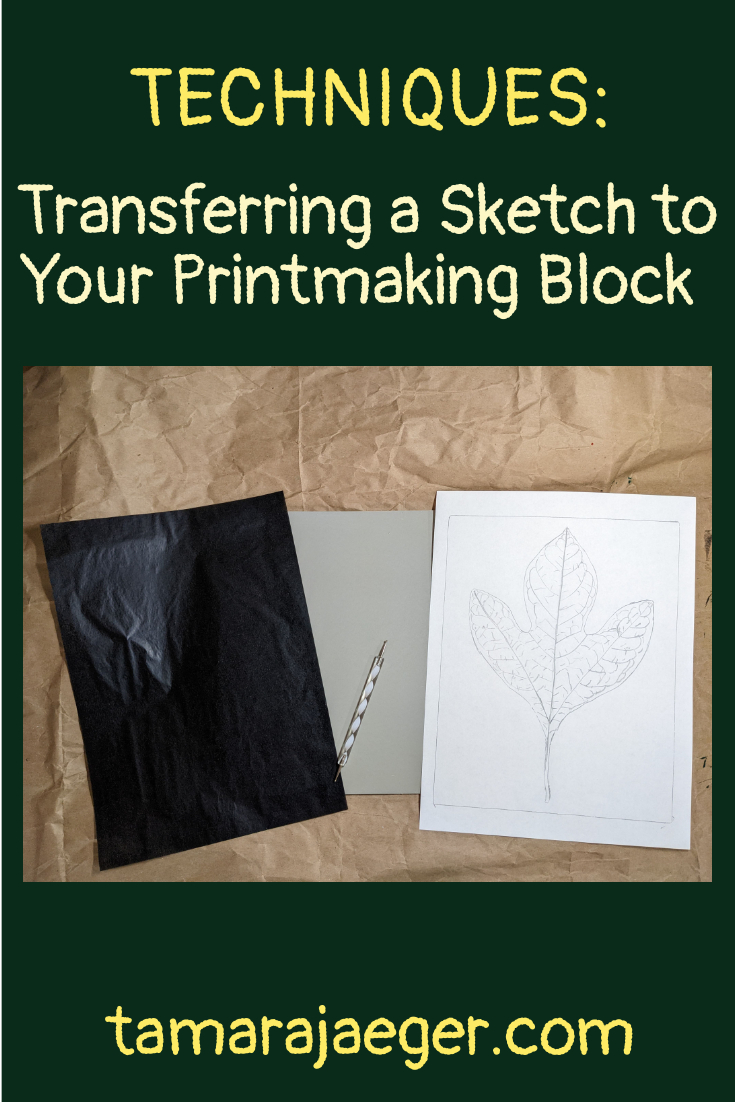

Transferring a Sketch to Your Printmaking Block
As a follow up to my last post about creating an underdrawing for a painting or collage, which you can find here, I’m going to talk a little bit about how to transfer your image onto the plate or block for making a print.
So, you have an image you want to make a print of but now you need to get it onto the block or plate. How can we do it? Well, there are actually a lot of options, and I’ll go over a few of them here.
First, you can obviously draw directly onto the plate. For linocuts, this works fine. You can use pencil or pen, though there’s a tendency for the drawing to smudge or smear while carving the block. You also need to keep in mind that the image you draw on your block will print in reverse—if you have lettering or other elements that need to appear in a specific direction, you need to make sure they are drawn out on the block backwards!

Another option is to take your drawing or image and scribble over the back with a thick layer of pencil. Then you place the image on top of the block and trace the design. Keep in mind that the image will again print in reverse from what is drawn in the sketch using this method.
If you need your image to appear in the same orientation as the drawing (as in, not reversed), you can first trace the design in pencil on the FRONT of the drawing, then turn the paper face down onto the block. Next, you can scribble (or trace, if you can see it) over the image (from the back) using a pencil to transfer the pencil lines on the front onto the block. This method is a little more time-consuming, since it’s multiple steps, but your image will appear reversed on the block, which means that the final printed image will not be reversed and will look just like the drawing.
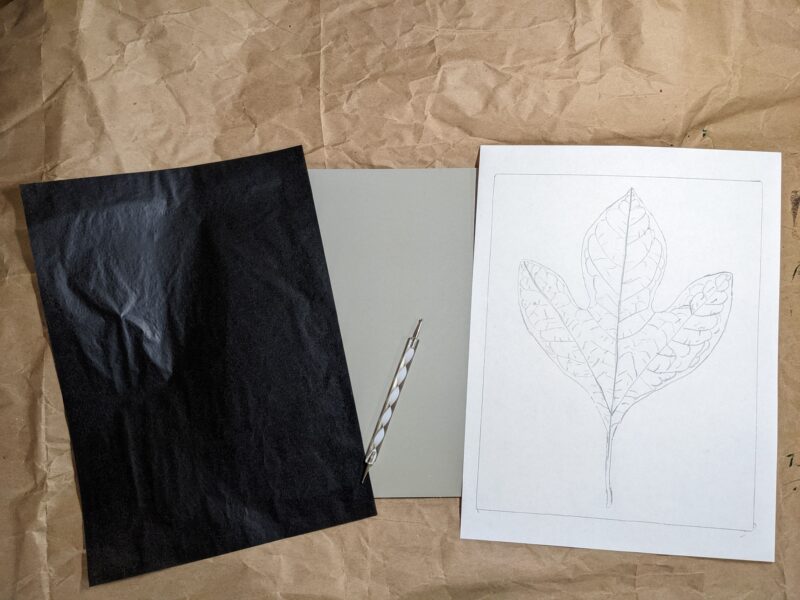
A bit easier that the pencil transfer method is using carbon paper or transfer paper. I switched to this a while back and it’s So much easier! Also, a lot less messy. You place a sheet of transfer paper between the block and the drawing (make sure the darker side, which is what actually transfers, is facing the block), then trace over the drawing using a pen, pencil, or stylus. Keep in mind, as always, that the image on the block will appear reversed in the final print. You can always use the two-step method above to trace the design onto the back of the paper, then trace that reversed image onto the block using the transfer paper. A lightbox can be a useful tool for retracing your drawing on the back, if you are having difficulty seeing the lines through the paper.
*Kingart Graphite Transfer Paper
*Artograph LightTracer Light Box
You can also use a projector to transfer the design, but unless you are working on a very large plate or have a projector that can focus very close to give a small image, it’s probably not an ideal method.
What tips or tricks have you found for transferring your image onto a printmaking plate or block? Tell me in the comments.
Want to stay up to date and see more of what I’m working on? Sign up for my mailing list here and get a FREE digital download of an exclusive tiger linocut print. (I promise not to be spammy with my emails—I hate that too!)
* Please note that this post contains affiliate links and any sales made through such links will reward me a small commission – at no extra cost for you.
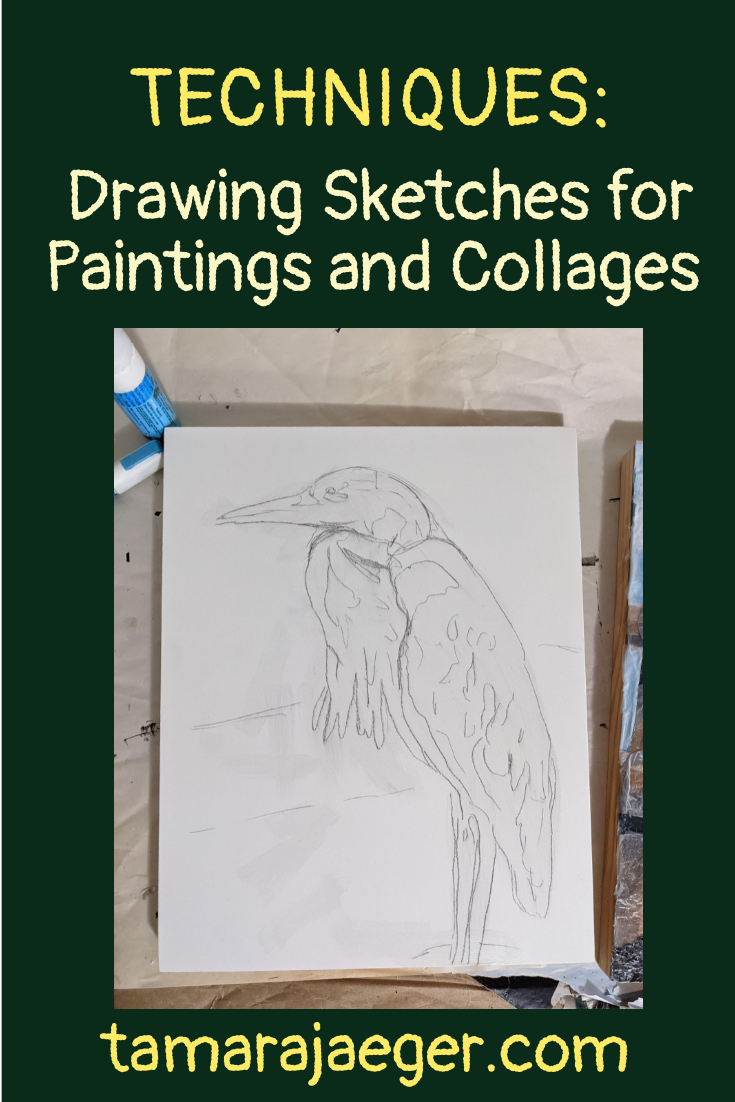

I’m Terrible at Drawing! How Can I Draw the Sketch for Paintings and Collages?
Let’s talk about underdrawings today. An underdrawing is a sketch of a design that is drawn on the paper, canvas, or panel prior to painting or otherwise creating the final artwork. The underdrawing serves to guide the artist during the creation of the piece and so is a critical part of the process—if the underdrawing isn’t right, it can be incredibly difficult to correct the composition while working on the piece.
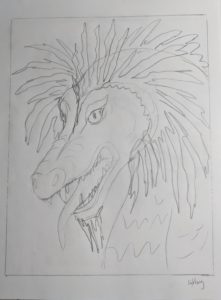
I confess, I actually don’t like drawing. I mean, I can do it, certainly, but it’s not something I do for fun. I’m definitely not one of those artists you see running around with a sketchbook, constantly drawing everything. But I can’t deny that drawing is a critical skill for creating my torn paper collages, paintings, prints, and other types of art.
“But I can’t draw!” I hear some of you saying. Well, the good news is that there are some ways around that.
The most common method you see in drawing classes is probably the use of a grid to help get the proportions and angles correct. It breaks up the overall composition into sections and allows you to concentrate on the shapes and lines without focusing as much on the overall image. While it’s generally seen as a tool for learning to draw, there’s no reason it can’t be used to help with creating an underdrawing from a reference photo.
To use the grid method, you just divide your paper or canvas into a series of squares, a bit like a chess board. You then do the same to the reference photo. You can also place a clear plastic sheet with a grid drawn on it over the top of your reference photo, if it’s something you don’t want to draw directly on. There are even grid tools you can purchase, such as these:
*QuicKomp artist’s drawing tool
Once you have your grids, you just focus on one square at a time and draw the lines and shapes exactly as you see them in the square. As long as each square is copied correctly, the entire image will be correctly drawn too.
Another useful method of transferring an image to your paper or canvas is the use of a projector. The method here is quite simple—you project the image onto your paper of canvas and trace what you see.
This is actually the method I use for most of my collages. Not because I can’t draw the images freehand, but because it speeds things up quite a bit and for a medium as time-consuming as torn paper collage, I’ll take any help I can get to streamline things! I usually batch my underdrawings by drawing out several pieces at once, so that I’m not constantly having to set up the projector and then put it away again (my studio is a bit too small to leave it set up all the time).
There are projectors made specifically for artists. They can be fairly expensive, but are probably a bit better for transferring images than some of the other options. As far as artist’s projectors go, there are two main types: ones you can place over a printed image to project it and ones that project digital images, like a slide or movie projector. Artograph is probably the most well-know brand, but there are some others out there.
The Artograph EZ Tracer Projector and the more expensive Artograph Inspire Art Projector are good choices for transferring from a printed image.
*Artograph EZ Tracer Projector
*Artograph Inspire art projector
Alternatively, you can get a regular movie/presentation projector from somewhere like Amazon and use that. As long as it will display still images, it should work reasonably well. The projector I’m currently using is of this type. It’s not perfect—since it’s designed to project images onto a very large screen, there’s a limit to how close you can focus, making it difficult to project onto smaller canvases or papers. But, it’s a good option for larger pieces. It’s still usable for smaller pieces but you might have to tweak the image file size or cropping to get it to a size that will be within the range of where the projector can focus.
Another option is to simply create your artwork on top of the reference photo—no drawing needed at all! This probably wouldn’t work well for most paintings, but would be fine for something like collage where you are gluing paper onto paper. Obviously, this isn’t a method you’d want to use if you don’t want your reference photo to be destroyed!
Have you tried any of these options? Do you have any other tips for creating the underdrawing? Let me know in the comments.
Want to stay up to date and see more of what I’m working on? Sign up for my mailing list here and get a FREE digital download of an exclusive tiger linocut print. (I promise not to be spammy with my emails—I hate that too!)
* Please note that this post contains affiliate links and any sales made through such links will reward me a small commission – at no extra cost for you.
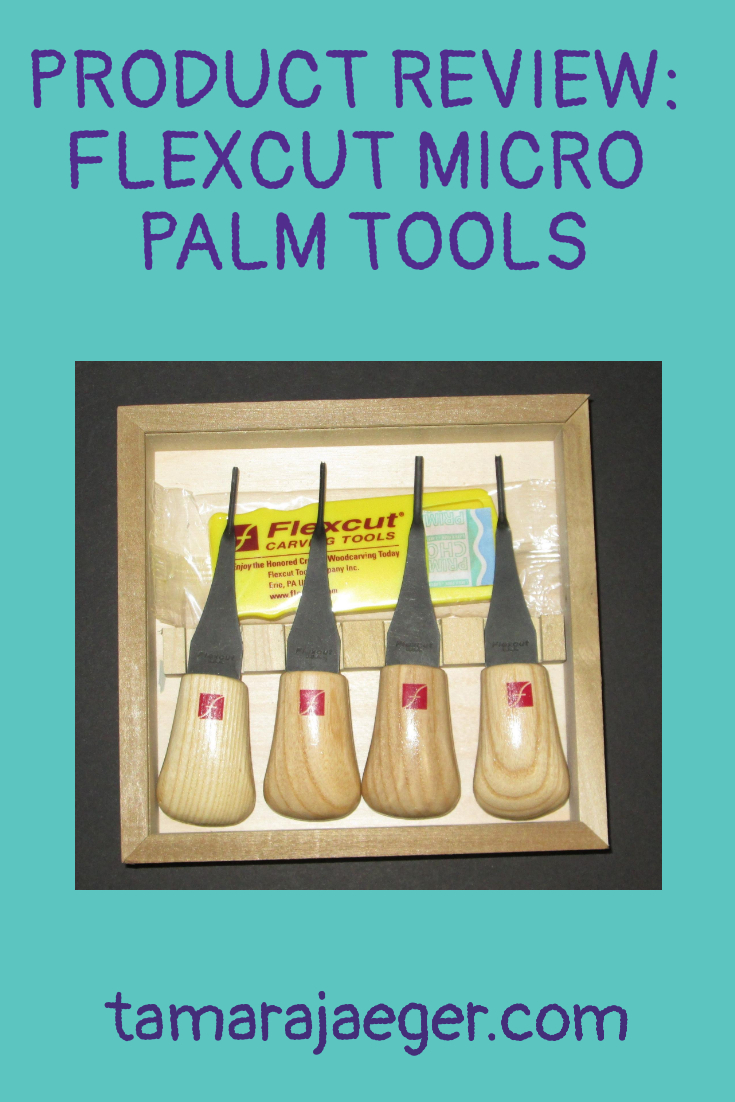

Product Review: Flexcut Micro Palm Carving Tools
In a previous post, I talked about my experience with Flexcut Lino and Relief printing carving tools here. Now, I didn’t like those tools At All. But I decided to give Flexcut another try. My main problem with the Lino carving set was the length and shape of the handle, and Flexcut has a much larger line of “Palm” tools, which looked to have a much shorter handle that fits easily into your palm.
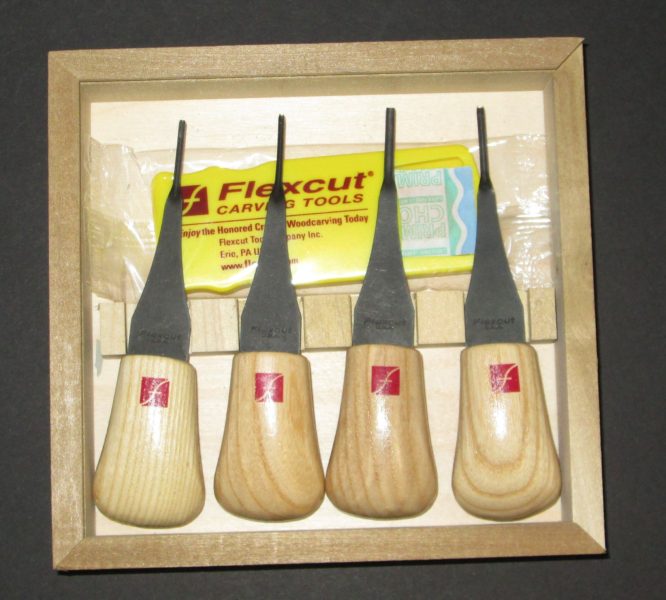
I do a lot of fine detail work in my linoleum prints, so I decided to try the Micro Palm Carving tool set. You can also get a “Beginner’s” set to start out with. The Micro set comes with four different, very tiny U- and V-shaped tools. They’re not cheap though. I was pretty nervous about the investment, especially considering how much I disliked the (cheaper) lino carving set. What if I also hated these and wasted so much more money?
So, I tried them out and I love, love, LOVE these tools! It was a totally different experience than with the lino carving set. The right shape and size of tool makes all the difference! I’m going to have to get a few more of the sets, I think. What I really need now is a wide gouge to carve out large areas of the block—I had to switch back to my Speedball cutter for that and it made me sad.
The Palm carving tools cut through linoleum like butter. I’ve always been a bit skeptical of that particular phrase, but it absolutely fits here! They seem much sharper than the Speedball cutters and seem to hold an edge much better than the lino carving set does too. They carve smoothly and easily, with minimal pressure and essentially no slippage. They’re a delight to use. I did need to hone them occasionally so keep them razor sharp, but that’s to be expected. I used the wooden strop and polishing compound that came with my lino carving set, but that (or something similar) can be purchased separately. The smallest micro tools can be difficult to sharpen due to their very tiny size, so I may need to invest in a different sharpening tool for those.
So if you prefer a palm-style carving tool, I absolutely recommend the Flexcut Palm tool line. They’re a bit pricey, but absolutely worth it. Quality-wise I do expect these tools to last for a long time.
Have you tried out and of Flexcut’s carving tools? What style and brand of cutters do you like? Tell me in the comments.
Want to keep updated and see more of what I’m working on? Sign up for my mailing list here and get a totally FREE digital download of a tiger linocut print. (I promise not to be spammy with my emails—I hate that too!)
* Please note that this post contains affiliate links and any sales made through such links will reward me a small commission – at no extra cost for you.
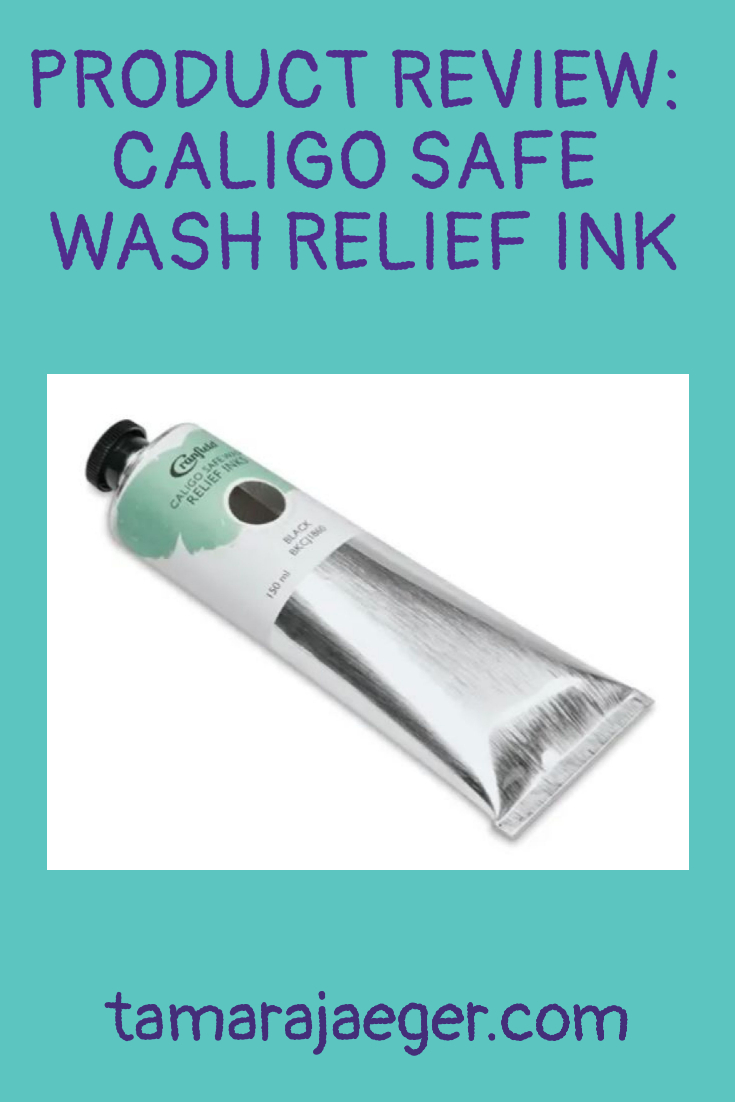

Product Review: Caligo Safe Wash Relief Inks
I haven’t been really happy with the water-based printing inks I’ve been using. They’re way better than traditional oil-based inks. They’re non-toxic, much easier to clean up and you don’t need to use solvents, which makes them much safer, particularly in a home-based studio.
Water-based inks can be difficult to work with, however, since they dry very quickly. This can be a benefit—oil-based inks can take a long time to dry! But it’s also a drawback, particularly in less-humid seasons. Working time can be Very short and it can be difficult to get an even print because the ink sometimes dries before I can get the whole piece printed. They do make mediums and additives to help extend the working time a bit, but it’s still quite short.
Since I don’t want to use hazardous solvents in my home (or at all, really!), I decided to look into some of the newer water-soluble oil-based printmaking inks. I’ve gotten great results with the water-mixable oil paints and Really like them a lot, so why give the inks a try?
I got a tube of the black Caligo Safe Wash Relief Ink by Cranfield Colors and I’m a complete convert. I Love this stuff! It works much like traditional oil-based ink, since it Is an oil-based ink. It rolls smoothly and gives a nice, rich black print. No worries about it drying out halfway through a print. It does bleed through thin paper a bit more than the water-based ink does, but I just put a piece of tracing paper over the printmaking paper when I’m printing by hand and it’s all good.
But what I love the most is the cleanup. It’s not quite as easy as a water-based ink and you do have to follow the instructions. You apply soap—I use a natural dish soap, and work it into the ink-covered areas Before adding water. I use a cheap bristle paintbrush to work the soap in. Then you wash it with water and the ink comes right off! I sometimes need to repeat the process a couple times, depending on how much ink was built up in the crevices, but it’s still super easy, if a bit messy.
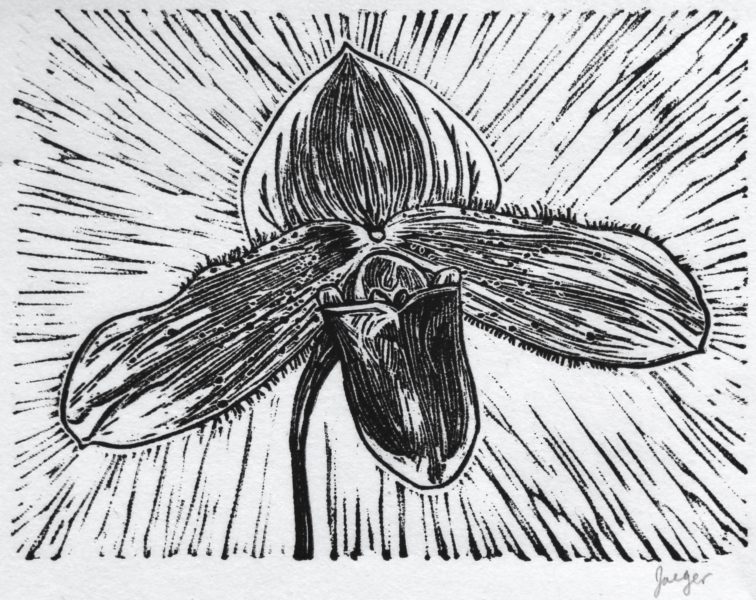
One thing to keep in mind is that if you use unmounted linoleum, like I do, you want to limit how much water comes in contact with the reverse of the linoleum since it can cause warping. I just try to keep the back as dry as possible when I’m washing it, then I dry the block off well and let it dry between paper towels under pressure.
I’ve also seen some cautions about using oil-based inks on the newer, rubbery linoleum alternative materials, like the pink ‘Speedy Carve’ by Speedball. I’ve used Caligo Safe Wash ink on a Speedy Carve block a couple times though and so far, the block seems fine. I don’t know if the oil in the ink will cause damage to the Speedy Carve block over the long term, or if cleaning it really well after use is enough. We’ll have to wait and see, I suppose. To be cautious, you might want to stick to water-based inks if you’re using the rubbery materials. Or not—be daring and live a little, right?
Anyway, I highly recommend Caligo Safe Wash Relief inks. They’re a fantastic alternative to traditional oil-based inks as far as safety and clean up goes, and superior to water-based inks in their working properties. The only thing I Really wish for is for Cranfield to add some metallics to their Caligo Safe Wash line. They have a gorgeous oil-based gold ink in their traditional oil-based line and I’d love to be able to get it in a water clean-up version.
What are your thoughts on the water-soluble inks and oil-paints? Have you tried any of them? Tell me below in the comments!
Want to keep updated and see more of what I’m working on? Sign up for my mailing list here and get a totally FREE digital download of a tiger linocut print. (I promise not to be spammy with my emails—I hate that too!)
* Please note that this post contains affiliate links and any sales made through such links will reward me a small commission – at no extra cost for you.
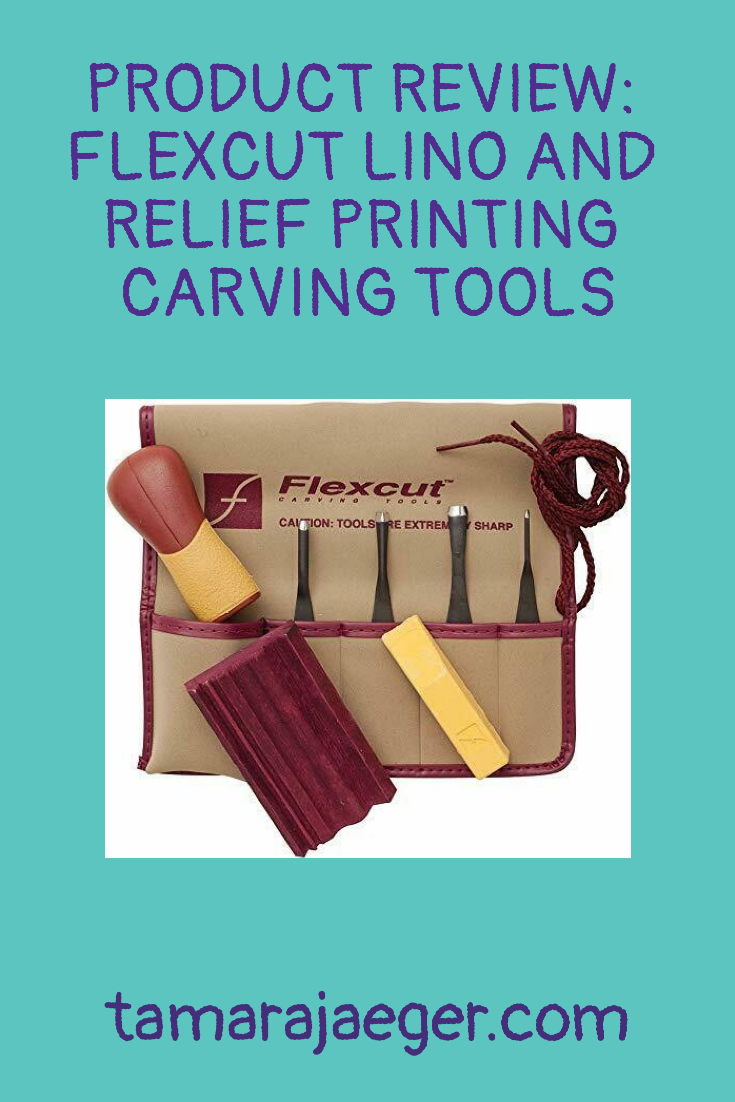

Product Review: Flexcut Lino and Relief printing carving tools
In my quest for a more enjoyable printmaking experience, I decided to look into upgrading my carving tools. Like with the wooden spoon I talked about here, I’ve been using the same student-grade carving tools I learned on. In particular, I’ve been using the Speedball linoleum cutters.
The Speedball cutter has a plastic handle with interchangeable blades in various shapes and sizes. The cutters do get dull eventually and you can either try and sharpen them a few times with a sharpening stone or just toss the blade and replace it with a new one. The replacement blades are fairly inexpensive and both the handle and the blades are relatively easy to find.
I don’t have any major issues with the Speedball cutters. They work well enough and the handle has a little storage compartment for the blades, which makes it compact and easy to store. But, I thought, why not try something new?
For my first excursion into the realm of new carving tools, I got the Flexcut Lino and Relief printmaking set. It’s not hugely expensive, but still a bit of a shock compared to the Speedball cutter. The set comes with four interchangeable blades of various sizes and shapes, one handle, a tool roll to hold the pieces, and a wooden strop and polishing compound for sharpening the blades.
Well, I tried them out and… I hate them. Absolutely detest them. I was so disappointed; the reviews were decent and they looked like they’d work well. Now, you might have a very different opinion—they’re a popular choice so it’s clear that many people Do like them. But I’ll tell you why I dislike them so much.
First, while they start off nice and sharp and carve through the linoleum well, they don’t seem to hold an edge well at all. I found myself having to hone them every few strokes in order to keep them cutting easily. The Speedball cutters definitely seem to hold an edge better. But that may just be a difference in the sharpness of the tools. Perhaps a slight dulling of the Flexcut tools is more apparent than with the Speedball cutter, since the Flexcut ones are sharper to start with.
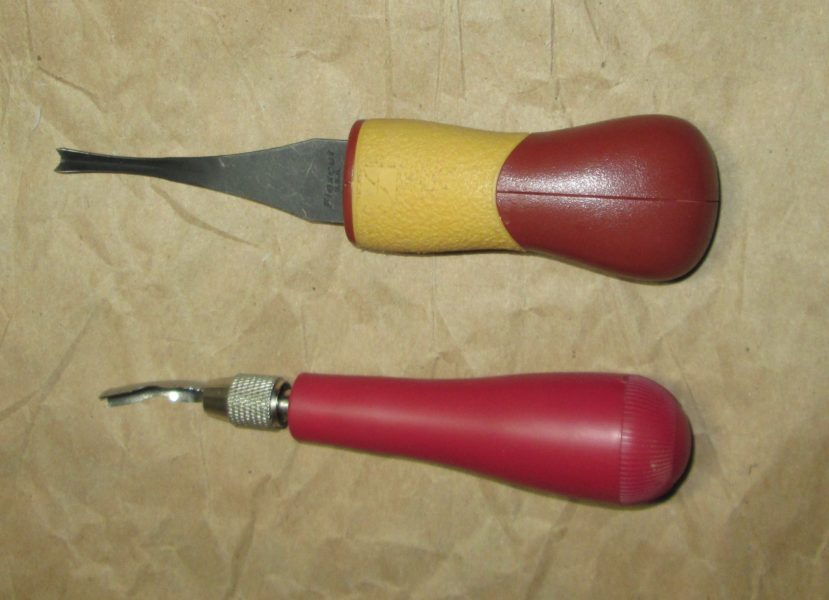
Second, the handle shape and size doesn’t work for me. At all. I had to hold my hand and wrist at an awkward angle that I quickly became excruciating (I injured my wrist way back when I was a teenager, and it still give me quite a bit of trouble, so the ergonomics of my tools is very important). The handle doesn’t look all that different in size compared to the Speedball cutter handle, but clearly, it’s different enough to be an issue for me. I found the least painful way of holding the tool was to put the blade in so that the handle was upside down—there’s a curve to it so that if fits in your palm better. I got a better angle with the ‘underside’ against my palm. It was still painful, but less so.
Another thing to take into consideration is that, while the blades are interchangeable, they fit Very tightly into the handle. While this means they’re not going to accidentally come loose, it does make it quite tricky to change the blade. Patience and a fair bit of hand strength is required. On a side note, it appears that you can purchase different styles of handle that fit the blades, so that’s an option I might look into in the future. The handles are fairly expensive though.
I don’t think I’ll be using these tools again since they simply don’t work for me. For now, it’s back to my trusty old Speedball cutters. But, I’ll definitely keep searching. There are so many different styles of carving tools; something has to work!
Now, don’t let my review scare you away from trying the Flexcut Lino and Relief printmaking set if you’re so inclined. Like I said, there are plenty of good reviews, so it works for a lot of people. And if you do try it, let me know what you think!
Want to keep updated and see more of what I’m working on? Sign up for my mailing list here and get a totally FREE digital download of a tiger linocut print. (I promise not to be spammy with my emails—I hate that too!)
* Please note that this post contains affiliate links and any sales made through such links will reward me a small commission – at no extra cost for you.
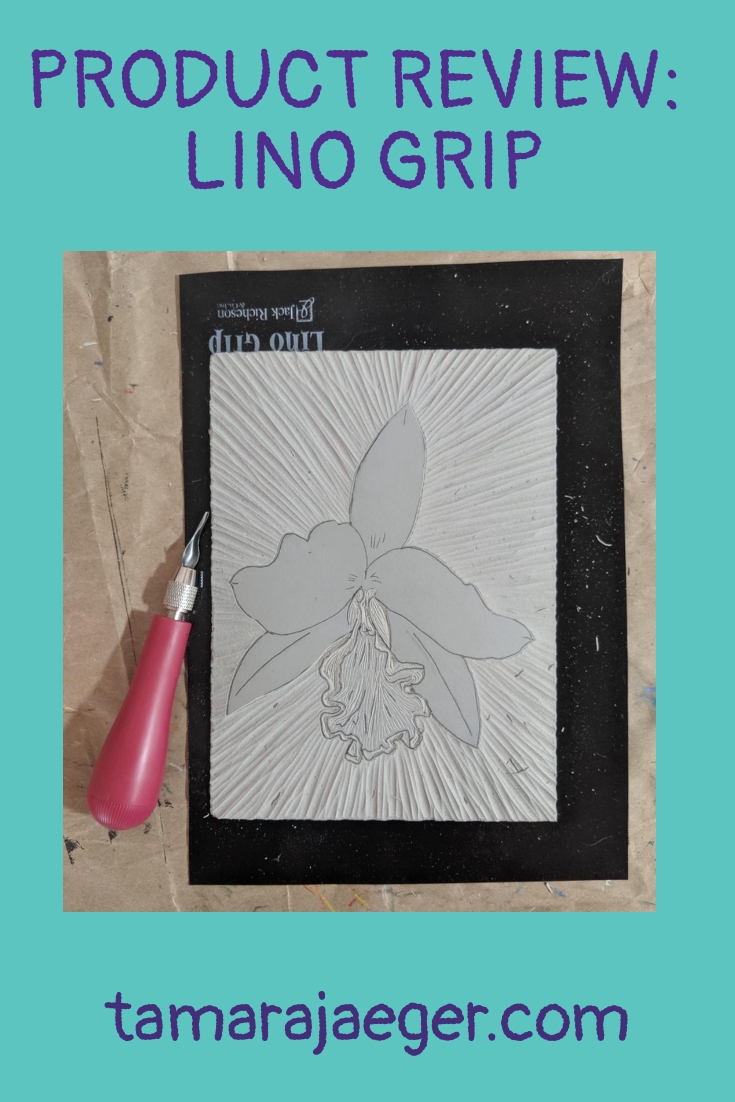

Product Review: Lino Grip
It happens to every printmaker at some point—you’re delicately carving away at your printing block and suddenly your block slips! Now there’s a big gouge right across your carefully carved design.
If you’re lucky, you can salvage it. Change the design slightly to accommodate the new line. Other times you have to start over from scratch.
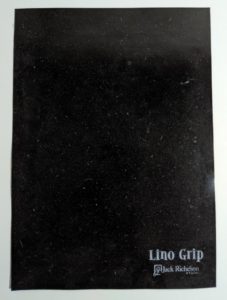
Several years ago, I ran across this little gem: Lino Grip by Jack Richeson. It’s a black plastic sheet that’s slightly sticky on both sides. You place it on your work table, then place your linoleum block on top. The tackiness of the surfaces helps to hold your block in place while you carve.
I confess that I’ve only recently tried out my Lino Grip sheet. I got it on sale shortly before I moved (“Hey, what a great idea! I’ve got to try it out!) and only recently rediscovered it when I dug out my printmaking supplies.
And I’m actually very pleased with it. It has enough tack to hold my linoleum block in place against the force of my carving without being too sticky or making it difficult to move or rotate the block. No slipping blocks here!
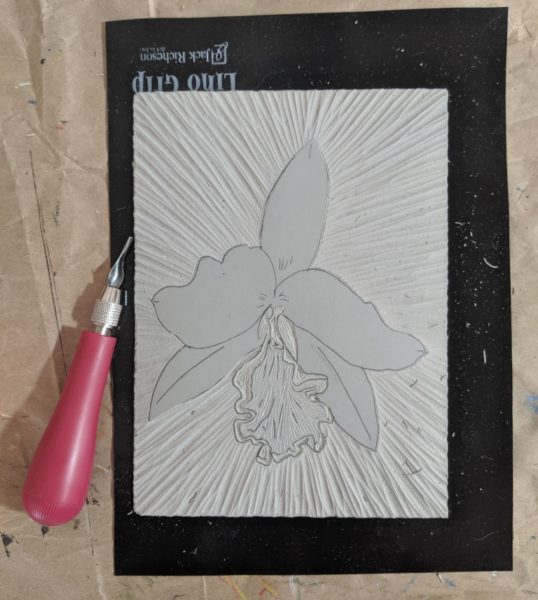
I’ve noticed a couple drawbacks. One is the size—it might be too small to hold a very large block in place. Though larger blocks seem to be less prone to slipping anyway, due to their larger contact area with the tabletop. I’m not sure if it comes in multiple sizes or not.
Another drawback—more of a mild annoyance, really—is that the tacky surface picks up lint and linoleum crumbs. It’s difficult to get and keep clean. I haven’t tried washing it yet—that might remove the debris without damaging the tackiness. I also suspect that the tackiness will eventually wear off. I’ll definitely update you if I notice that happening!
In the meantime, it’s time to carve!
Have you ever tried Lino Grip or anything similar? How do you hold your block in place for carving?
Want to keep updated and see more of what I’m working on? Sign up for my mailing list here and get a totally FREE digital download of a tiger linocut print. (I promise not to be spammy with my emails—I hate that too!)
* Please note that this post contains affiliate links and any sales made through such links will reward me a small commission – at no extra cost for you.
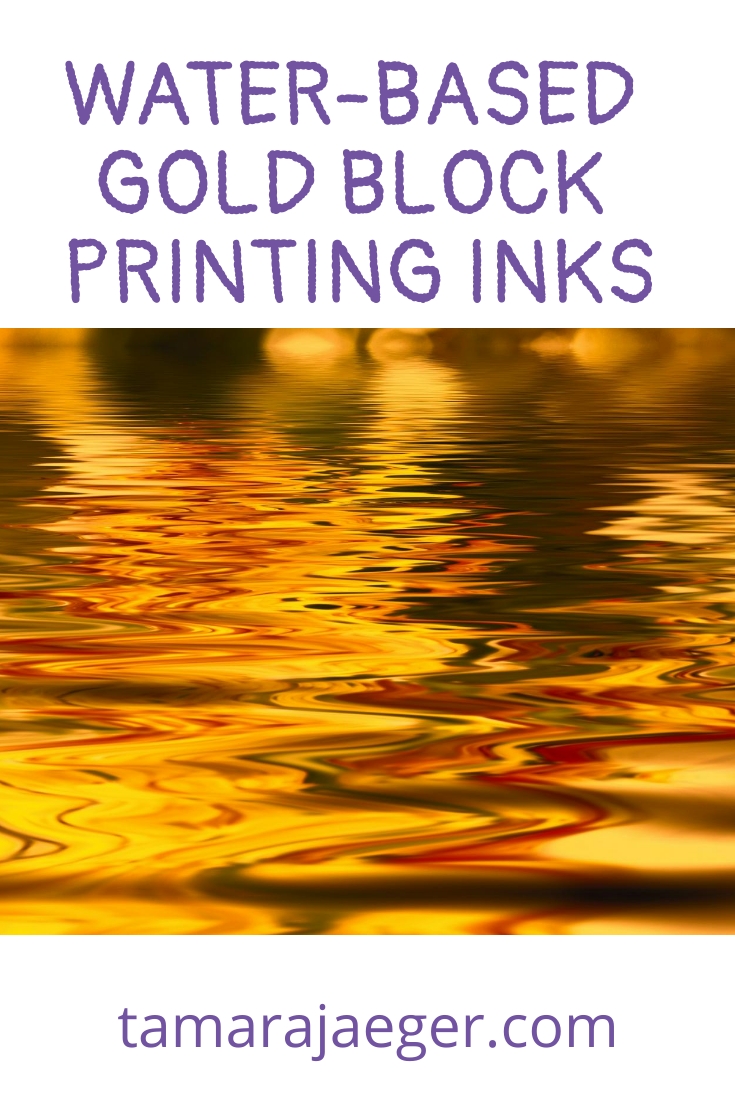

Review: Water-Based Gold Block Printing Inks
If you’ve been following along with me, you know that I’ve been working quite a bit lately on linocut block prints (if you haven’t been following me, you can check out some of my earlier posts here and here). I’ve been trying out some new printing inks, trying to find ones that have better working properties than the ones I had been using previously but that are still easy to clean up without solvents and with good lightfastness.
and here). I’ve been trying out some new printing inks, trying to find ones that have better working properties than the ones I had been using previously but that are still easy to clean up without solvents and with good lightfastness.
One of the colors I’ve enjoyed printing in is gold. It’s kind of difficult to find gold block printing ink in general and even harder to find a good one!
Today, I’d like to compare two of the inks I’ve tried out so far: Speedball Water-Based Gold Block Printing Ink and Schmincke Aqua Gold Linoprint Ink.
I’ve used the Speedballwater-based inks for years. They’re easy to find, inexpensive, non-toxic, and very easy to clean up with soap and water. I’ve never been very happy with their working properties, however, which has led me to my current quest to find a ‘better’ block printing ink.
Speedball Water-Based Block Printing Ink
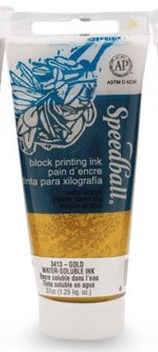
The issue I have with all the water-based Speedball inks is their poor working properties. They dry too quickly, especially in warm weather or in the winter when the indoor humidity is low. This makes it difficult to print the image evenly, since you have to work Very quickly. I’ve often only managed to get a couple good prints at a time, with many more that are poor quality—patchy or with faded areas. But they do make a gold ink. It’s not terrible. More of a coppery color than gold, in my opinion.
Schmincke Aqua Linoprint Ink
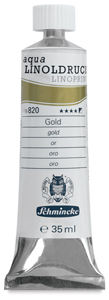
I discovered Schmincke Aqua linoprint inks online recently. They’re water-based, so they clean up easily and without needing to use harsh solvents. The reviews I read were generally quite favorable so I decided to give them a try. They’re not cheap, however.
I had such high hopes when I rolled this ink out on the plate! Sadly, so far I hate the ink. Like, really hate it. To be fair, the color of the gold ink is fantastic. It’s a nice, bright, iridescent gold. I just could not get a good print out of it. Now, it may be that I just need to spend some time experimenting to figure out the best technique for inking the plate and printing the piece. My current technique certainly doesn’t seem to be working!
I had two main issues with the Schmincke ink—getting good ink coverage on the plate and removing the paper from the plate after printing. The Schmincke ink is, I think, a thinner consistency than the Speedball ink. This is good in that it lets you print fine details more easily, without clogging up the plate and filling in shallow cuts—a definite issue with the Speedball inks. Indeed, the Schmincke ink did give me more delicate-looking lines in the finished print. The problem was that I couldn’t get it to stick to the entire plate evenly so I lost a lot of detail in the overall image. It’s almost like the ink simply wouldn’t stick to the plate. It was incredibly frustrating. I thought at first it might be an issue with residual oil from the other ink I had used on the plate, but I had the same problems when I tried it out on a plate that I had only ever used water-based inks on.
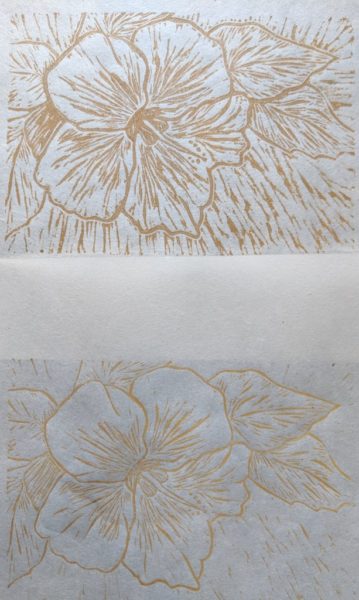
On the other hand, once I inked the plate and printed it, it was very difficult to pull the paper off the block. That sucker was stuck down like I had used superglue! Weird, considering how hard it was to get the ink on the plate in the first place. Now it doesn’t want to come off? The ink does seem to get Very sticky as it dries. I like to use a thin Japanese paper for my linocut prints but this paper gets bent and warped and distorted trying to pull it off the plate with the Schmincke ink. A heavier paper may help with this; I’ll have to give it a try and see.
So far, I have one ink that prints okay-ish with an indifferent color ( Speedball) and one ink with a stunning color and a terrible printing experience ( Schmincke). I definitely will continue to test out the Schmincke ink to see if I can figure out a way to get good prints with it. I really do like the color!
If you’re interested, you can also read my thoughts on Caligo Safe Wash water-soluble block printing ink here (spoiler alert: I love it!). Sadly, Caligo doesn’t have any metallics in their Safe Wash line. The do have a gold ink in their traditional oil-based ink line that I may have to try out, despite the greater difficulty in clean up.
Have you tried out any water-based printing inks? What about metallic inks? What have your experiences been with them? Tell me below!
* Please note that this post contains affiliate links and any sales made through such links will reward me a small commission – at no extra cost for you.
Want to keep updated and see more of what I’m working on? Sign up for my mailing list here and get a totally FREE digital download of a tiger linocut print. (I promise not to be spammy with my emails—I hate that too!)
